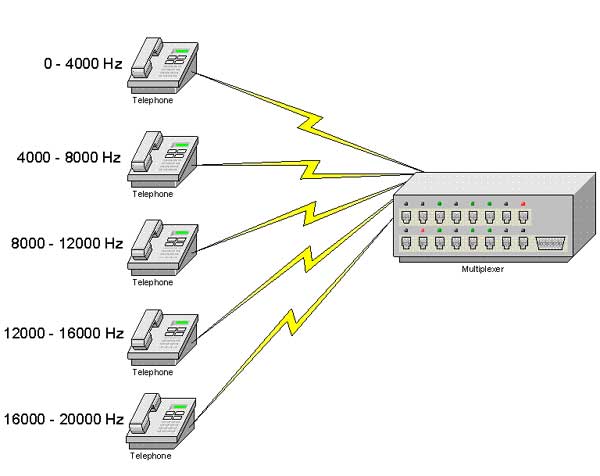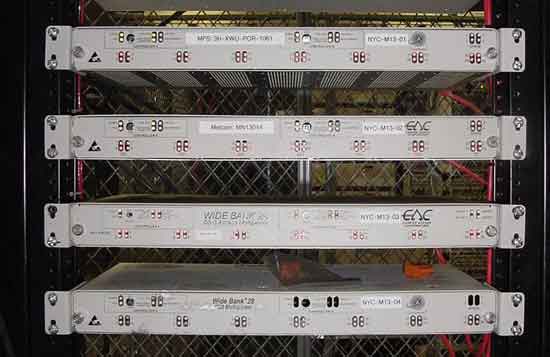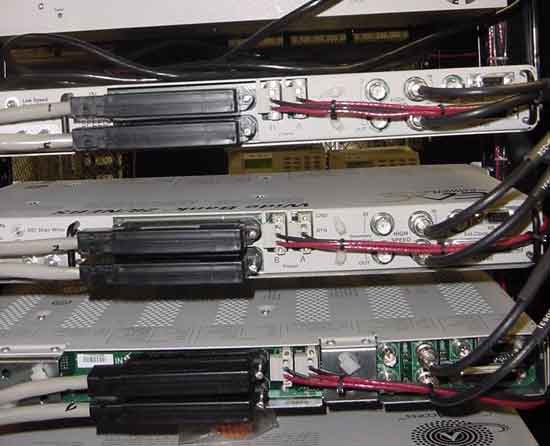
|

|

|

|

|

|

|

|

|

|

|

|

|

|

|

|

|

|

|

|

|

|

|

|

|

|

|

|

|

|
 |
|
|
|
|
Mailing List
|
|
By Joining the mailing list you will be notified of site updates.
|
|
Show Your Support For
This Site By Donating:
|
|
|
|
|


|
|
|
|
|
|

Multiplexing
By Erik Rodriguez
This article describes the method of multiplexing. It is a method used in date networks to send data from multiple sources through one physical line. Multiplexing is
is used in conjuction with SONET and dark fiber.
Multiplexing has been around for ages. As a briefly mentioned above, multiplexing is used to send and receive multiple segments (or packets) of data.
The main advantage of multiplexing is that you can send a lot data over 1 physical line. It was first used in telephone networks to relay voice
conversations over twisted [wire] pairs. There are several types of multiplexing:
| Frequency Division Multiplexing |
| Time Division Multiplexing |
| Dense Wavelength Division Multiplexing |
Frequency Division Multiplexing (FDM)
FDM was developed to work with early telephone networks. It worked by dividing the freqencies to support multiple users. For instance, with a standard sound spectrum (20 Hz - 20,000 Hz) the frequencies would be equally divided to support 5 or so users per physical line. Note that in this case, users are given some of the frequency all the time. FDM is still used with cable TV, some older analog cellular systems, and most commonly YOUR FM RADIO! See the figure below:

Time Division Multiplexing (TDM)
TDM was developed later (late 1950's) with new "digital" technology. This works a little different than FDM, in that users are given all of the frequency some of the time. The way TDM actually works is pretty complicated, so I'm not going to explain it in much detail. However, the process involves converting signals from analog to digital. TDM not only allows more data to be sent over a physical medium, it provides a better quality of service (QoS). TDM comes in two flavors, Synchronous TDM and Statistical TDM. Synchronous TDM is widely used with T carriers and ISDN. Statistical TDM is more complex but more efficient. It makes better decisions about transmitting bandwidth.
Dense Wavelength Division Multiplexing (DWDM)
DWDM is a modification of TDM and FDM. It is sometimes called wave division multiplexing It performs the same function of multiplexing data, but it uses different colored lasers to send multiple channels over the same physical line. DWDM only runs over fiber optic lines but has an advantage because it can combine multiple connection types such as ATM, OC, etc into one physical fiber line. Now, DWDM works just like FDW in that it divides frequencies into channels. However, it uses a special "colored" laser to send each segment of frequencies. At first, this was a problem. If there were 14 channels all using a unique laser color, keeping extra lasers around (for each color) was expensive. Today, this problem is
solved by using a special laser that can be "tuned" to any color in the event that one stops operating. If you look into DWDM more closely, you will be amazed how complex this method is.
So what is a Multiplexer?
A multiplexer is the device that performs the actual "data compression." It works much like a switch does on a regular LAN. They are generally very expensive depending on what type, brand, and features you want. It is pretty safe to assume that the general public does not shop for multiplexers. Below are some images of them from a carrier central office.
A front and back view of a DS3 multiplexer.

 Contact Us
Contact Us
NOTE: this form DOES NOT e-mail this article, it sends feedback to the author.
|
|
|
|
|
|
